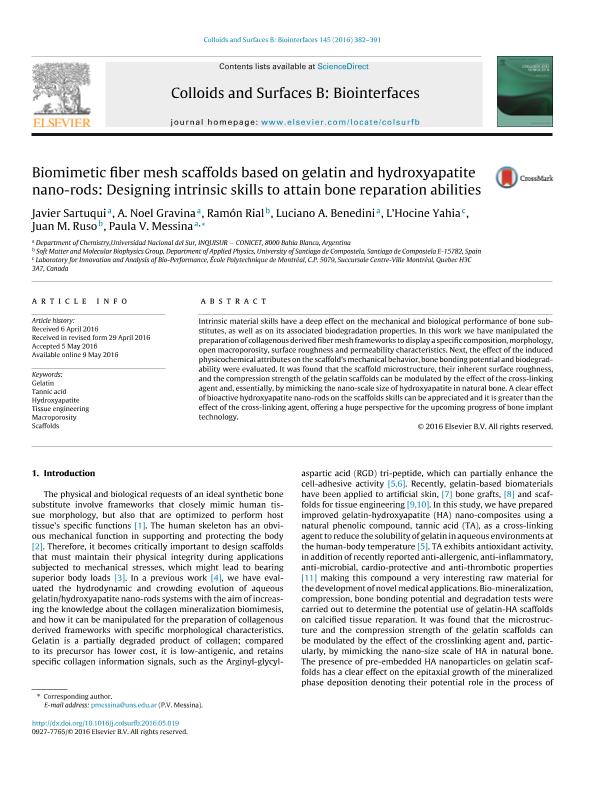Artículo
Biomimetic fiber mesh scaffolds based on gelatin and hydroxyapatite nano-rods: Designing intrinsic skills to attain bone reparation abilities
Sartuqui, Javier ; Gravina, Noel
; Gravina, Noel ; Rial, Ramón; Benedini, Luciano Alejandro
; Rial, Ramón; Benedini, Luciano Alejandro ; Yahia, L'Hocine; Ruso, Juan M.; Messina, Paula Verónica
; Yahia, L'Hocine; Ruso, Juan M.; Messina, Paula Verónica
 ; Gravina, Noel
; Gravina, Noel ; Rial, Ramón; Benedini, Luciano Alejandro
; Rial, Ramón; Benedini, Luciano Alejandro ; Yahia, L'Hocine; Ruso, Juan M.; Messina, Paula Verónica
; Yahia, L'Hocine; Ruso, Juan M.; Messina, Paula Verónica
Fecha de publicación:
01/09/2016
Editorial:
Elsevier Science
Revista:
Colloids and Surfaces B: Biointerfaces
ISSN:
0927-7765
Idioma:
Inglés
Tipo de recurso:
Artículo publicado
Clasificación temática:
Resumen
Intrinsic material skills have a deep effect on the mechanical and biological performance of bone substitutes, as well as on its associated biodegradation properties. In this work we have manipulated the preparation of collagenous derived fiber mesh frameworks to display a specific composition, morphology, open macroporosity, surface roughness and permeability characteristics. Next, the effect of the induced physicochemical attributes on the scaffold's mechanical behavior, bone bonding potential and biodegradability were evaluated. It was found that the scaffold microstructure, their inherent surface roughness, and the compression strength of the gelatin scaffolds can be modulated by the effect of the cross-linking agent and, essentially, by mimicking the nano-scale size of hydroxyapatite in natural bone. A clear effect of bioactive hydroxyapatite nano-rods on the scaffolds skills can be appreciated and it is greater than the effect of the cross-linking agent, offering a huge perspective for the upcoming progress of bone implant technology.
Palabras clave:
Gelatin
,
Hydroxyapatite
,
Macroporosity
,
Scaffolds
,
Tannic Acid
,
Tissue Engineering
Archivos asociados
Licencia
Identificadores
Colecciones
Articulos(INQUISUR)
Articulos de INST.DE QUIMICA DEL SUR
Articulos de INST.DE QUIMICA DEL SUR
Citación
Sartuqui, Javier; Gravina, Noel; Rial, Ramón; Benedini, Luciano Alejandro; Yahia, L'Hocine; et al.; Biomimetic fiber mesh scaffolds based on gelatin and hydroxyapatite nano-rods: Designing intrinsic skills to attain bone reparation abilities; Elsevier Science; Colloids and Surfaces B: Biointerfaces; 145; 1-9-2016; 382-391
Compartir
Altmétricas



